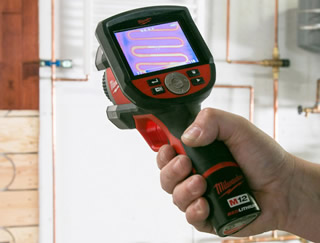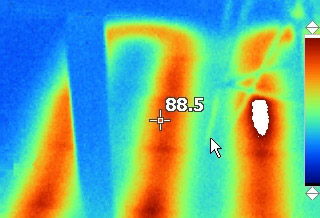Where's that Freakin' Leak? - Page 2
 |
|
|
 |
|
|
They are now working on a way to take stereoscopic microphones on pipes and download that data to an iOS device, allowing technicians to pinpoint where the leak is on a specific section of pipe. Being able to more closely pinpoint a damaged pipe can help a team access a leak with less damage to the existing structure because they know exactly where to go.
Another method used is thermal imaging, which photographs changes in temperature using an infrared camera. The camera registers cool temperatures as blue, and warm as red, with the range of color between the two representing the spectrum of heat.
Technicians can use thermal imaging to map out an entire radiant heat system. Like most technology, the price of thermal imaging equipment has come down significantly over the years—from as much as $30,000 down to $3,000.
For domestic water lines, a line locator uses an electromagnetic transmitter that charges metal pipes and even electric wires. The mild magnetic charge then registers on a hand-held antenna or 'wand.' This technique is used to identify where utility lines are located within a structure. It can't be used on radiant heat systems, however, because the radiant tubing is coiled too close to itself, about a foot apart, making the fields indistinguishable.
"Electromagnetic technology has been around as many as 50 years, and it's the standard way to find pipes because it's tried and tested," Macaulay says.
In Eichlers, detecting leaks from domestic water lines can be tricky because they are located underneath roughly six inches of concrete. Because these pipes are located in dirt, however, they wear out more slowly than their radiant system counterparts.
In this instance, or in the case of a very small leak, companies use a detection device called a dielectric molecular analyzer. This sensitive device detects helium or hydrogen atoms in the air. Since helium atoms are much smaller than atmospheric air, they can pass through smaller leaks, which might not be flowing heavily enough to detect with the listening device or other devices.
With an analyzer, the system is charged with helium or a combination of helium and hydrogen. The atoms are small enough to pass through the concrete as well as the leak, and since they are lighter than air, they tend to travel upward. Usually wherever the ‘sniffer' detects the atoms, the leak is directly below.




